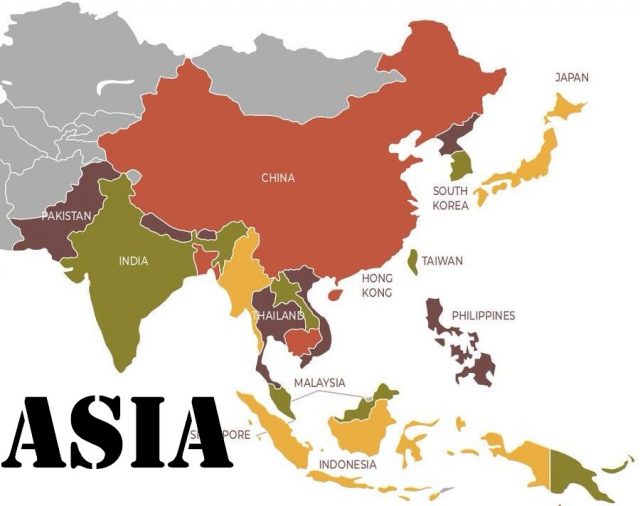In Asia, three languages are found, which are also spoken in other parts of the Euro-Afro-Asian major continent: Indo-European, Semitic and Oral languages. Many attempts have been made and are still being made to prove an overall kinship between these three lineages, but although some limited common vocabulary may be plausible, it is still an uncertain hypothesis.
In addition, escalutic languages (Eskimo and Aleutian), represented by some Eskimodialects in northern Siberia.
The Indo-European languages are Armenian in Armenia and neighboring Turkey; Iranian languages in Iran, Afghanistan and in enclaves north of Tajikistan. This language set also includes Indian languages in Pakistan and Northern India, with the exception of the Tibetan-Burmese language. The Indian languages include Hindi/Urdu, Bengali, Panjabi and Marathi.
The Semitic languages, Arabic, Aramaic and Hebrew, are spoken in Arabia and in the countries between the Mediterranean and Iran.
The oral languages in Asia are Samoan, Eastjackish and some other languages in NV-Siberia.
| Country | Proportion of women in Parliament (percent) | Public Expenditure on Health Care Per Person (US Dollar) |
| Afghanistan | 28 (2018) | 57 (2016) |
| Bahrain | 8 (2018) | 1,099 (2016) |
| Bangladesh | 20 (2018) | 34 (2016) |
| Bhutan | 9 (2018) | 91 (2016) |
| Brunei | 9 (2018) | 631 (2016) |
| Burma | 10 (2018) | 62 (2016) |
| Philippines | 30 (2018) | 129 (2016) |
| United Arab Emirates | 23 (2018) | 1 323 (2016) |
| India | 12 (2018) | 63 (2016) |
| Indonesia | 20 (2018) | 112 (2016) |
| Iraq | 26 (2018) | 153 (2016) |
| Iran | 6 (2018) | 415 (2016) |
| Israel | 28 (2018) | 2 837 (2016) |
| Japan | 10 (2018) | 4 233 (2016) |
| Yemen | (2018) | 72 (2015) |
| Jordan | 15 (2018) | 224 (2016) |
| Cambodia | 20 (2018) | 78 (2016) |
| Kazakhstan | 27 (2018) | 262 (2016) |
| China | 25 (2018) | 398 (2016) |
| Kyrgyzstan | 19 (2018) | 73 (2016) |
| Kuwait | 3 (2018) | 1,068 (2016) |
| Laos | 28 (2018) | 55 (2016) |
| Lebanon | 5 (2018) | 662 (2016) |
| Malaysia | 14 (2018) | 362 (2016) |
| Maldives | 6 (2018) | 1,048 (2016) |
| Mongolia | 17 (2018) | 141 (2016) |
| Nepal | 33 (2018) | 45 (2016) |
| North Korea | – | – |
| Oman | 1 (2018) | 648 (2016) |
| Pakistan | 21 (2018) | 40 (2016) |
| Qatar | 10 (2018) | 1 827 (2016) |
| Saudi Arabia | 20 (2018) | 1,147 (2016) |
| Singapore | 23 (2018) | 2,462 (2016) |
| Sri Lanka | 6 (2018) | 153 (2016) |
| South Korea | 17 (2018) | 2 044 (2016) |
| Syria | 13 (2018) | 66 (2012) |
| Tajikistan | 19 (2018) | 56 (2016) |
| Taiwan | – | – |
| Thailand | 5 (2018) | 222 (2016) |
| Turkmenistan | 25 (2018) | 423 (2016) |
| Uzbekistan | 16 (2018) | 135 (2016) |
| Vietnam | 27 (2018) | 123 (2016) |
| East Timor | 34 (2018) | 80 (2016) |
Asian languages
In addition to the above there are a number of languages that are closely related to or exclusively spoken in the continent: Altaic languages, Chinese (or sinitiske language), Tibeto-Burmese language, taisprog, Austronesian languages (formerly malajo-Polynesian language), austroasiatiske languages (formerly Mon-Khmer) and finally Dravidian languages. In addition, there are some languages that do not seem to belong in these groups, says Countryaah.
Altaic languages are an experimental set of languages that are far from being accepted by all linguists. It contains Tongan languages in Eastern Siberia with enclaves of Mandurian in Northern China, Turkish languages in Asia Minor, Central Asia and northern Siberia, as well as Mongolian languages in Mongolia and Chinese Mongolia. It is thought that Korean belongs to the Altaic genus, and this genus is wanted by some linguists extended to Japanese.
Chinese consists of a number of so-called dialects, which are also called Sinitic languages. The main Sinitic language is Mandarin (with Putonghua or modern Standard Chinese) spoken by 65% of China’s population. It is thus the world’s most widely spoken language.
Tibetan-Burmese languages are spoken in Tibet, in Myanmar (Burma), in neighboring areas and in pockets in Western China. The Karan languages in Myanmar and Miao-yao (hmong-man) in Guizhou and in the Indochinese peninsula are similar in structure to Tibetan-Burmese languages. However, some linguists attribute miao-yao to austro-tai.
The Thai languages are spoken on the Indochinese peninsula and in southern China. The main Thai languages outside China are Siamese or Thai in Thailand, Lao or Laotian in Laos and Northeast Thailand, as well as Shan and Khamti in Myanmar. An intermediate position between the Tai and the Austronesian languages occupies the Kadais languages compiled by the American Paul Benedict in 1942. It is li or hlai in Hainan and three languages in the China-Vietnam border area.
Austronesian languages are found in an extensive area. They are spoken in South Asia and Taiwan and also in Madagascar and throughout the Pacific. In Malaysia and Indonesia, respectively, Bahasa Malaysia and Bahasa Indonesia, which are basically the same language and are collectively referred to as Malay. Similarities with Austronesian showcase the languages jakun, sakai and semang in western Malaysia.
Austroasiatiske language on the Southeast Asian mainland consists of language families Mon-Khmer, Nicobar language and munda. Mon-Khmer is the language mon or tala in Myanmar, Khmer or Cambodian in Cambodia and in southern Vietnam as well as Vietnamese. In addition, a large number of mountain languages, of which only kammu in northern Laos and neighboring areas have many speakers. The Mundan languages are spoken in large pockets in the central Indian provinces south of the Ganges between the Ganges Delta and the river Narmada. cantaloupe and mundar.
Dravidian languages are spoken throughout South India as well as in enclaves north of Pakistan and in Sri Lanka. These languages include: Tamil, Telugu and Malayalam.
Some languages that cannot be genetically positioned are the almost extinct ainu in northern Japan and Sakhalin, Guillian in Sakhalin and Amur, Luoravetlian languages in the extreme northeastern corner, and Jakagir in a small pocket west of Luoravetlian and Ket (Jenisej Cheyenne) by Jenisej. A genetically isolated language is burushaski in Hunza.
Asia – Health conditions
The large differences between the disease patterns in Asia’s individual countries reflect the very large differences between the countries’ economic development and infrastructure.
In East Asia, Japan has reached the highest life expectancy in the world, and at the same time, strong economic growth in China and South Korea has led to a gradually improving state of health. These countries have also achieved better control over population growth.
South Asia’s populous states of India, Pakistan and Bangladesh have high child mortality and low life expectancy. Sri Lanka has achieved a somewhat similar development stage with reduced child mortality and higher life expectancy.
West Asia’s oil-rich states have had large financial resources available, such as has been used to expand the social infrastructure. Despite this, in many of the countries it has not significantly improved the health of the rural population and the guest workers.
The Central Asian region of Asian Russia and the southern republics is marked by the disintegration of the Soviet Union, which has led to economic problems and a decline in the quality of infrastructure. In this way, the risk of flare-ups among others. waterborne illnesses, diphtheria and measles increased.
In South and South Asia, many countries have poor water supplies, resulting in high mortality rates due to diarrheal diseases, especially in children. In these areas there is widespread malnutrition and malnutrition. In many countries malaria, leprosy and tuberculosis continue to occur. So far, the incidence of patients with AIDS is low.

